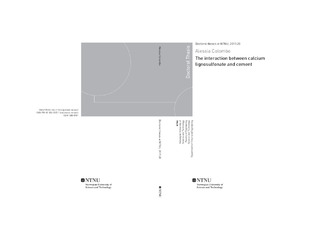| dc.description.abstract | Modern concrete applications intensify the need for highly-flowable concretes, which are at the same time durable and possess good mechanical properties. The addition of plasticizers to the concrete mix allows obtaining highly workable concretes maintaining low water-to-binder ratios, which is beneficial for compressive strength and durability.
However, the addition of plasticizer can cause retardation in the setting time of concrete, which limits the dosage of plasticizer usable in practice. In addition, incompatibility issues can exist between plasticizer and cement, possibly leading to higher LSs dosage needed to reach a given workability, severe setting retardation, rapid set, and sudden slump loss.
In this PhD thesis, a sugar-reduced softwood calcium lignosulfonate (LSs) was used as plasticizer. The LSs was used in pastes of two Portland cements with different chemical composition and specific surface area: a CEM I 52.5 N (ANL) and a CEM I 52.5 R (CX), as defined by the European Standard EN197-1:2011.
The first objective of this PhD thesis is to understand the mechanisms behind the interaction between lignosulfonate and cement. This is important to foresee the effects of the plasticizer on workability and setting time of cement, avoiding any possible incompatibility issue.
In light of the mechanisms of consumption of LSs by the cement paste, the impact of the LSs on the rheology and setting time of the cement paste was studied. This represented the second objective of this PhD thesis.
The investigations in this first phase of the PhD project brought in light that the amount and morphology of the ettringite formed in the cement paste played a major role in the rheological and setting behaviour of the cement pastes investigated. For this reason, the third objective of this PhD thesis was to investigate more deeply the impact of the LSs on ettringite.
The investigations undertaken in this PhD thesis highlighted that, when added immediately with the mixing water (immediate addition, IA), the LSs led to an increased formation of ettringite after 30 minutes of hydration, especially for the high-C3A cement (CX). No increase in the ettringite formed was detected when the LSs was added after 10 minutes of hydration (delayed addition, DA). The ettringite had cubic or rectangular prism shape and length between 0.1 and 0.4 µm. The ettringite morphology appeared unaltered when observed after 6 hours of hydration. Therefore, the LSs was found not to change the morphology of ettringite in the systems analysed in this PhD thesis.
The large amount of ettringite formed provided additional surface area, which increased the LSs consumption for monolayer surface adsorption. This was found to be the main mechanism of LSs consumption for CX cement both for IA and for DA. Monolayer surface adsorption was also found to be the main mechanism of LSs adsorption for ANL cement for DA, while other mechanisms, still to be determined, appeared to play a role for ANL cement for IA. For both cements, calcium complexation, multilayer adsorption and intercalation in AFm were considered unlikely.
The large amount of ettringite formed appeared to decrease the workability of cement paste, leading to early stiffening and, in some cases, to rapid set. The workability of cement paste with LSs also seemed directly correlated to the degree of LSs coverage of the available surface for adsorption. A sudden drop in yield stress and viscosity was measured for the cement pastes that reached an adsorption plateau (DA). Samples which did not reach surface saturation (IA) showed a more gradual increase in workability, requiring higher LSs dosages when compared to those needed for DA. However, for DA, both cement pastes were found to be very sensitive to variations in LSs dosage: even a small increase from the optimal LSs dosage could lead to sudden slump loss.
As to the impact of LSs on setting time, the setting retardation was found to be directly correlated to the amount of free LSs in the pore solution. The DA of LSs was found to lead to higher setting retardation, because of the lower LSs consumption by the cement paste compared to when the LSs was added with IA. This led to a higher amount of free LSs available to retard C3S hydration. In the samples where the highest amount of ettringite was formed, the increased LSs adsorption caused by the additional surface area reduced the amount of free LSs in the pores solution. This was reflected in lower setting retardation, which was measured with isothermal calorimetry. In addition, increasing LSs dosages led to larger retardation of the silicate peak compared to the aluminate one, causing the two peaks to merge. This can potentially lead to poisoning of C3S hydration and severe delay of setting, causing incompatibility between plasticizer and cement.
In conclusion, the use of the LSs studied in this PhD thesis in combination with cement characterized by high C3A content and fineness appears critical, as possibly leading to incompatibility issues such as higher LSs dosage needed to reach a given workability, severe setting retardation, rapid set, and sudden slump loss. Therefore, before using LSs in the concrete practice, special attention should be paid to the combination between the LSs and the cement chosen. | nb_NO |
